Notes:The First World War brought with it, as at many other major stations, the need to transport thousands of troops to Western Front. Following the declaration of war against Germany on 4 August 1914 the Birmingham Daily Mail reported:
‘Busy scenes were witnessed at Snow Hill during the morning. Reservists from all quarters of the city arrived with friends almost continuously and between nine and ten o’clock two contingents of Territorials marched into the station from their barracks’.
As the conflict wore on, troop trains were timetabled to stop in the station so that food and drink could be taken from the platform refreshment rooms. Ambulance trains became a familiar sight, either stopping or passing through. With the railways under the control of the Railway Executive Committee, and shortages both of labour and rolling stock, many of the local services emanating from Snow Hill were curtailed for the duration of the conflict. Following the cessation of hostilities, the railway gradually resumed its usual day-to-day activities. There was one exception to this: the advent of the day-tripper or ‘flapper set’ as they were known. The citizens of Birmingham started to use the railway for day trips to such places as Stratford-upon-Avon and Weston-super-Mare, buoying up the coffers of the booking office at Snow Hill.
The rail strike of 26 September to 5 October 1919 inflicted irreparable damage on the railways, with small haulage businesses springing up overnight, many new and existing haulage companies were equipped with ex-army lorries sold off by the Government after the First World War taking valuable business away from the railways. The Government and the GWR took the strike very seriously indeed and Snow Hill saw the troops of the Worcestershire Regiment billeted within the station. The station was guarded 24 hours a day by soldiers with fixed bayonets. By 1920 services had returned to pre-war levels and Snow Hill entered what is quoted as being its ‘Golden Era’. The GWR had responded to the increased demands of the day-trippers by introducing cheap excursions which the citizens of Birmingham flocked to the station to use; luring them with cheap half-day and full- day return tickets to London, 6s 0d (30p) for a full day or 3s 6d (17½p) for the half day, the booking office could take in excess of £1,000 per day (approximately £190,000 by 2016 values).
At the time of the Big Four ‘Grouping’ on 1 January 1923, the station stayed within the GWR and was still one of their largest stations, outside Paddington. It was renowned for its cleanliness and efficiency. The whole station was kept spotlessly clean with platforms regularly swept and an absence of litter made train-spotters of the time describe it as the only station in Birmingham to pursue their hobby; a veteran train-spotter, in recent conversation with the author, dismissed .jpg) Birmingham New Street as ‘foreign’ but lavished praise on Snow Hill as a ‘wonderful place to spend the day spotting on a penny platform ticket’. Snow Hill also boasted its own fire brigade made up of well-trained station employees who were generously equipped with fire-fighting equipment. The brigade rehearsed a ‘dry drill’ every two months and a ‘wet drill’ every three months. The ‘wet drill’ ensured that the station was washed from roof to platform and usually took place on a Sunday morning. Birmingham New Street as ‘foreign’ but lavished praise on Snow Hill as a ‘wonderful place to spend the day spotting on a penny platform ticket’. Snow Hill also boasted its own fire brigade made up of well-trained station employees who were generously equipped with fire-fighting equipment. The brigade rehearsed a ‘dry drill’ every two months and a ‘wet drill’ every three months. The ‘wet drill’ ensured that the station was washed from roof to platform and usually took place on a Sunday morning.
During 1934 a new Snow Hill to Cardiff service was launched using stylish, Swindon-built, diesel railcars. The diesel railcar was designed to provide express-type speeds on routes where train loading was not sufficiently high to justify running a standard length train. The railcars were a success in cutting operating costs and a popular with the general public even when the company charged a supplementary fare of 2s 6d (12½p) in addition to the normal third class fare. A small buffet was also included in the express versions of the railcars, and they were highly rated for their comfort and good riding qualities. Further batches were delivered from Swindon and they became an increasingly familiar sight on lightly used routes, often working out of Snow Hill on the Dudley service.
With the declaration of war against Germany on 3 September 1939 the railways once again came under the control of the government through the Railway Executive Committee. The GWR had steadily been moving equipment and troops through Snow Hill since the Munich crisis of 1938, and around 6,000 Anderson air raid shelters per week were being moved by the goods department to various sites around the Birmingham area. Later in September 1939 the station played its part in the movement of hundreds of evacuees towards the relative safety of the countryside in hastily prepared trains using virtually any available motive power. In May 1940 the station received the first of many casualties from Dunkirk who were treated in the former dining room of the restaurant, .jpg) the room having been converted into an emergency casualty station. The aerial bombardment of the city became relentless during the latter part of 1940, although the station managed to escape relatively unscathed. It was not until that the 50th air raid on the city on the night of 19 and 20 November 1940 that the station was hit. A large explosion, close to or directly above the station entrance on Colmore Row, destroyed all of the glass in the arch roof above the booking hall with both faces of the, prominent, station clock being damaged. Thankfully no-one was killed although several members of staff within the booking office were injured by flying glass. Snow Hill had escaped lightly as elsewhere in the city 1,500 people were either killed or injured during that single air raid. It was not until the night of 8 and 9 April 1941 that the station received any further significant damage. A high-explosive bomb pierced the roof above platform 5 (Wolverhampton platform) bringing down a large proportion of the roof, destroying the ladies’ waiting room and a bookstall. On the same evening a second bomb exploded on the fish dock, south of the main London platform, slightly damaging the arch of the Colmore Row overbridge. A third projectile hit the steel deck carrying the sidings to platform 11 and penetrated the parcels yard beneath the station causing extensive damage. The station was patched up for the remainder of the conflict with no further significant damage recorded. the room having been converted into an emergency casualty station. The aerial bombardment of the city became relentless during the latter part of 1940, although the station managed to escape relatively unscathed. It was not until that the 50th air raid on the city on the night of 19 and 20 November 1940 that the station was hit. A large explosion, close to or directly above the station entrance on Colmore Row, destroyed all of the glass in the arch roof above the booking hall with both faces of the, prominent, station clock being damaged. Thankfully no-one was killed although several members of staff within the booking office were injured by flying glass. Snow Hill had escaped lightly as elsewhere in the city 1,500 people were either killed or injured during that single air raid. It was not until the night of 8 and 9 April 1941 that the station received any further significant damage. A high-explosive bomb pierced the roof above platform 5 (Wolverhampton platform) bringing down a large proportion of the roof, destroying the ladies’ waiting room and a bookstall. On the same evening a second bomb exploded on the fish dock, south of the main London platform, slightly damaging the arch of the Colmore Row overbridge. A third projectile hit the steel deck carrying the sidings to platform 11 and penetrated the parcels yard beneath the station causing extensive damage. The station was patched up for the remainder of the conflict with no further significant damage recorded.
Following the end of hostilities the GWR set about repairing the fabric of the damaged station with the station being completely re-glazed during 1946. After years of wartime hardship the citizens of Birmingham again flocked to the station during the summer months to take advantage of excursion trains. With rationing still in force and private car ownership limited the railways were the only means by which the vast majority of people could get away, be it for a day or a little longer. The GWR was in the process of trying to address the backlog of maintenance which had taken its toll on the system in what became its last two years of ownership.
On 1 January 1948 the railway network was nationalised, becoming British Railways (BR). Birmingham Snow Hill was placed under the control of the Western Region (WR), where allegiances to the former GWR would take many years, if not decades, to fade away. A new corporate identity for the WR was devised by the BR Board and Snow Hill was effectively re-.jpg) branded during 1948 to 1951. The station was firstly repainted; champagne beige was heavily used for basic paintwork with mouldings, scrolls and other relief work finished in beech brown. GWR running-in nameboards and station signs were replaced with new vitreous enamel signage with a beech brown background and cream lettering. The corrosive atmosphere created by steam engines within the station ensured that the station had to be repainted every five years, with an army of painters using 20 tons of lead paint. branded during 1948 to 1951. The station was firstly repainted; champagne beige was heavily used for basic paintwork with mouldings, scrolls and other relief work finished in beech brown. GWR running-in nameboards and station signs were replaced with new vitreous enamel signage with a beech brown background and cream lettering. The corrosive atmosphere created by steam engines within the station ensured that the station had to be repainted every five years, with an army of painters using 20 tons of lead paint.
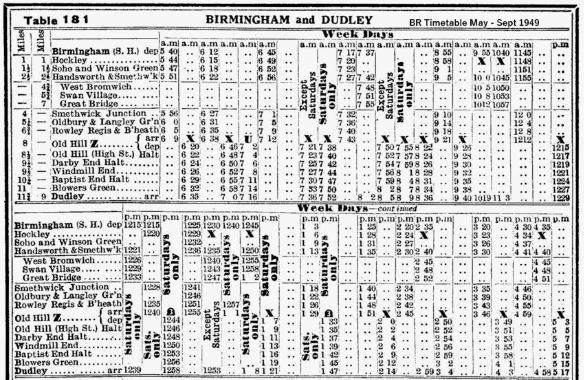
The 1950s saw little change to the station environment. Snow Hill was still the efficient and clean station it had been under the GWR. However, the train-spotters started to notice a change: foreign engines started appearing, with the first of the BR Standard Classes, and some found it a little disconcerting. To add to this, in 1956 the King Class locomotive of GWR origin was found to have a defect inherent to the whole class and they were temporarily withdrawn so that repairs could be swiftly completed. The London Midland Region (LMR) lent the WR many locomotives during that time and the sight of a Princess Coronation or a Princess Royal Pacific heading an express train through Snow Hill was not uncommon. The petrol rationing resulting from the Suez crisis of 1956 saw many extra trains run by the WR during the holiday period from Snow Hill, mainly to the West of England and South Wales.
In 1958 the LMR started its West Coast Main Line (WCML) electrification programme between London Euston and Birmingham New Street, and to counter the effect of a reduction in service on the WCML the WR started running an increased frequency on the London Paddington to Wolverhampton Low Level route. This, in turn, increased passenger numbers travelling to and from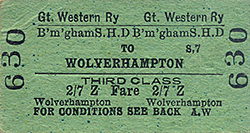 Snow Hill; in 1960, 7½ million passenger journeys were undertaken on 130,000 trains. A new era seemed to have arrived for the station as, also in 1960, the new diesel Pullman train made its appearance. This exclusive service ran on Monday-to-Friday between Snow Hill and Paddington with the first class return fare quoted as £3 10s 0d (£3.50) and second class at £2 7s 0d (£2.35) with 10s 0d (50p) and 5s 0d (25p) supplementary Pullman fare payable in first and second class respectively; a bottle of champagne would have set you back 34s 6d (£1.72½p). During the period of 1958 to 1960 the last major repairs to the steel work at Snow Hill were completed and the station received its final full re-paint. Snow Hill; in 1960, 7½ million passenger journeys were undertaken on 130,000 trains. A new era seemed to have arrived for the station as, also in 1960, the new diesel Pullman train made its appearance. This exclusive service ran on Monday-to-Friday between Snow Hill and Paddington with the first class return fare quoted as £3 10s 0d (£3.50) and second class at £2 7s 0d (£2.35) with 10s 0d (50p) and 5s 0d (25p) supplementary Pullman fare payable in first and second class respectively; a bottle of champagne would have set you back 34s 6d (£1.72½p). During the period of 1958 to 1960 the last major repairs to the steel work at Snow Hill were completed and the station received its final full re-paint.
Birmingham South and Birmingham North signal boxes were replaced on 11 September 1960 by Birmingham signal box which consisted of a Henry Williams Integra entrance-exit signalling panel located in the former third class ladies’ waiting room on platform 1/5. It was to operate until closure on 6 March 1972, being officially abolished on 17 September. The signalman operating the panel was said to have a lonely job in the early 1970s with a huge gap between trains from the morning until the evening rush hour.
Tickets from Michael Stewart & Brian Halford
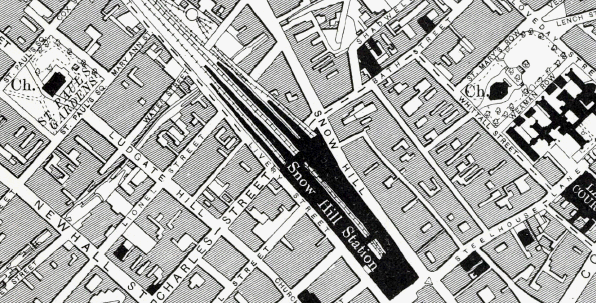 The rebuilt Snow Hill station seen on the 1920 six inch map. The rebuilt Snow Hill station seen on the 1920 six inch map.
|

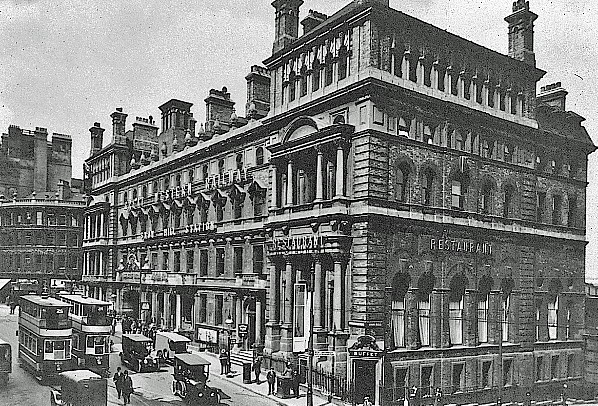
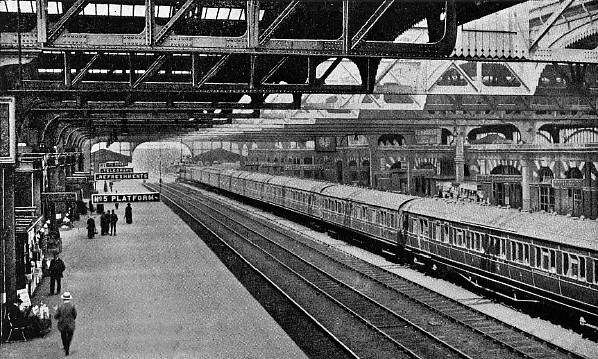
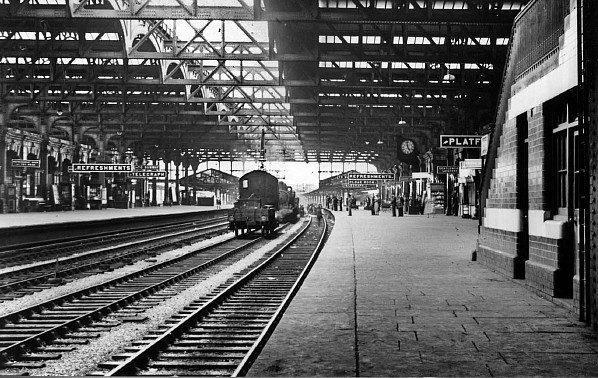
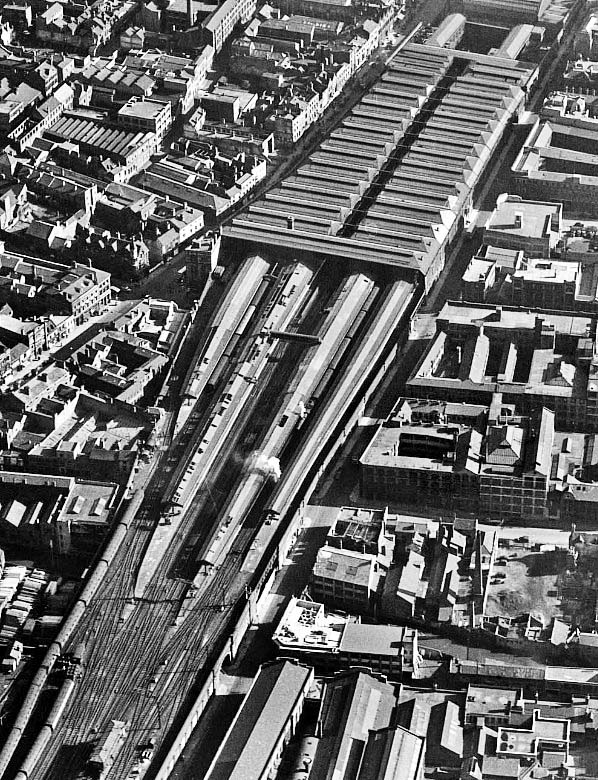
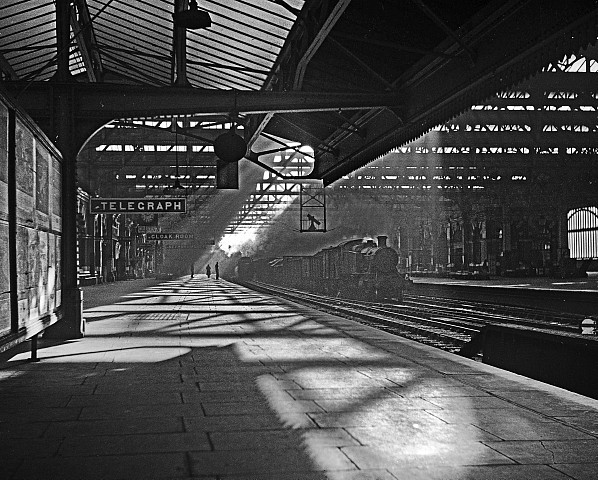
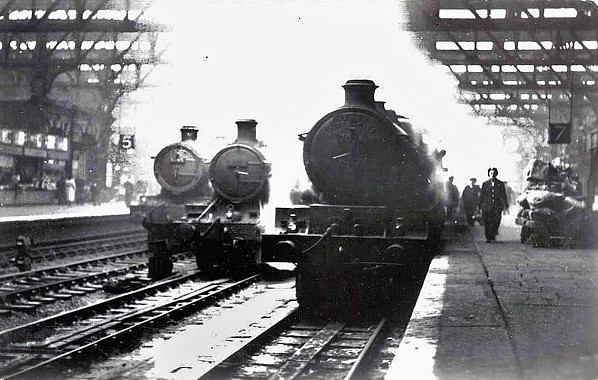
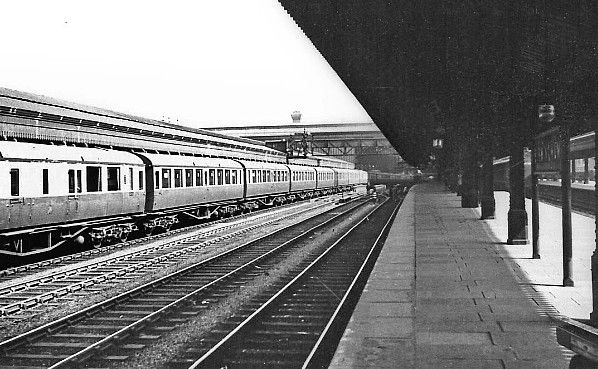
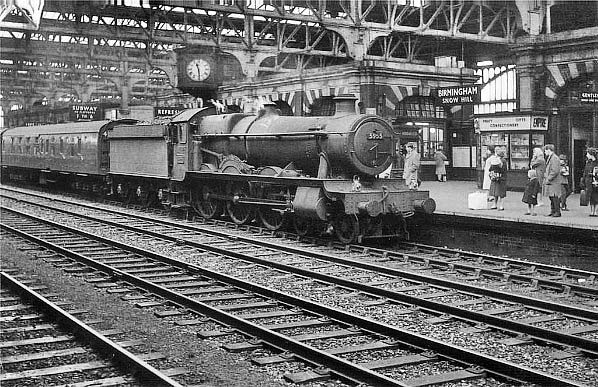
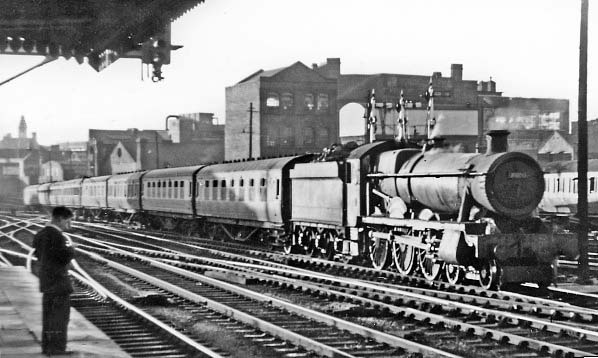
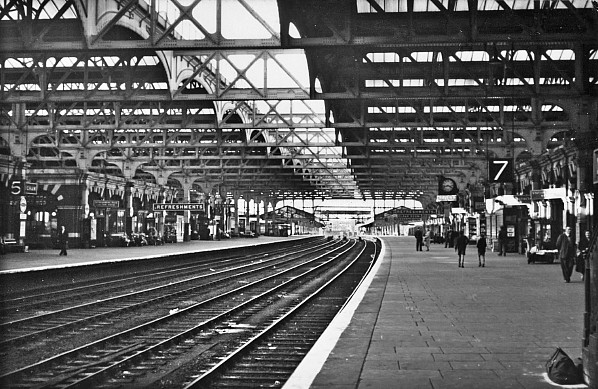
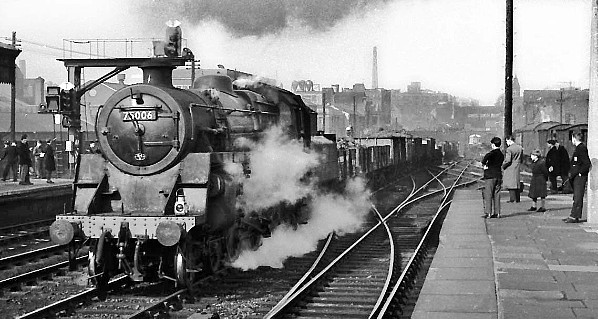
.jpg) Birmingham New Street as ‘foreign’ but lavished praise on Snow Hill as a ‘wonderful place to spend the day spotting on a penny platform ticket’. Snow Hill also boasted its own fire brigade made up of well-trained station employees who were generously equipped with fire-fighting equipment. The brigade rehearsed a ‘dry drill’ every two months and a ‘wet drill’ every three months. The ‘wet drill’ ensured that the station was washed from roof to platform and usually took place on a Sunday morning.
Birmingham New Street as ‘foreign’ but lavished praise on Snow Hill as a ‘wonderful place to spend the day spotting on a penny platform ticket’. Snow Hill also boasted its own fire brigade made up of well-trained station employees who were generously equipped with fire-fighting equipment. The brigade rehearsed a ‘dry drill’ every two months and a ‘wet drill’ every three months. The ‘wet drill’ ensured that the station was washed from roof to platform and usually took place on a Sunday morning..jpg) the room having been converted into an emergency casualty station. The aerial bombardment of the city became relentless during the latter part of 1940, although the station managed to escape relatively unscathed. It was not until that the 50th air raid on the city on the night of 19 and 20 November 1940 that the station was hit. A large explosion, close to or directly above the station entrance on Colmore Row, destroyed all of the glass in the arch roof above the booking hall with both faces of the, prominent, station clock being damaged. Thankfully no-one was killed although several members of staff within the booking office were injured by flying glass. Snow Hill had escaped lightly as elsewhere in the city 1,500 people were either killed or injured during that single air raid. It was not until the night of 8 and 9 April 1941 that the station received any further significant damage. A high-explosive bomb pierced the roof above platform 5 (Wolverhampton platform) bringing down a large proportion of the roof, destroying the ladies’ waiting room and a bookstall. On the same evening a second bomb exploded on the fish dock, south of the main London platform, slightly damaging the arch of the Colmore Row overbridge. A third projectile hit the steel deck carrying the sidings to platform 11 and penetrated the parcels yard beneath the station causing extensive damage. The station was patched up for the remainder of the conflict with no further significant damage recorded.
the room having been converted into an emergency casualty station. The aerial bombardment of the city became relentless during the latter part of 1940, although the station managed to escape relatively unscathed. It was not until that the 50th air raid on the city on the night of 19 and 20 November 1940 that the station was hit. A large explosion, close to or directly above the station entrance on Colmore Row, destroyed all of the glass in the arch roof above the booking hall with both faces of the, prominent, station clock being damaged. Thankfully no-one was killed although several members of staff within the booking office were injured by flying glass. Snow Hill had escaped lightly as elsewhere in the city 1,500 people were either killed or injured during that single air raid. It was not until the night of 8 and 9 April 1941 that the station received any further significant damage. A high-explosive bomb pierced the roof above platform 5 (Wolverhampton platform) bringing down a large proportion of the roof, destroying the ladies’ waiting room and a bookstall. On the same evening a second bomb exploded on the fish dock, south of the main London platform, slightly damaging the arch of the Colmore Row overbridge. A third projectile hit the steel deck carrying the sidings to platform 11 and penetrated the parcels yard beneath the station causing extensive damage. The station was patched up for the remainder of the conflict with no further significant damage recorded. .jpg) branded during 1948 to 1951. The station was firstly repainted; champagne beige was heavily used for basic paintwork with mouldings, scrolls and other relief work finished in beech brown. GWR running-in nameboards and station signs were replaced with new vitreous enamel signage with a beech brown background and cream lettering. The corrosive atmosphere created by steam engines within the station ensured that the station had to be repainted every five years, with an army of painters using 20 tons of lead paint.
branded during 1948 to 1951. The station was firstly repainted; champagne beige was heavily used for basic paintwork with mouldings, scrolls and other relief work finished in beech brown. GWR running-in nameboards and station signs were replaced with new vitreous enamel signage with a beech brown background and cream lettering. The corrosive atmosphere created by steam engines within the station ensured that the station had to be repainted every five years, with an army of painters using 20 tons of lead paint.
 Snow Hill; in 1960, 7½ million passenger journeys were undertaken on 130,000 trains. A new era seemed to have arrived for the station as, also in 1960, the new diesel Pullman train made its appearance. This exclusive service ran on Monday-to-Friday between Snow Hill and Paddington with the first class return fare quoted as £3 10s 0d (£3.50) and second class at £2 7s 0d (£2.35) with 10s 0d (50p) and 5s 0d (25p) supplementary Pullman fare payable in first and second class respectively; a bottle of champagne would have set you back 34s 6d (£1.72½p). During the period of 1958 to 1960 the last major repairs to the steel work at Snow Hill were completed and the station received its final full re-paint.
Snow Hill; in 1960, 7½ million passenger journeys were undertaken on 130,000 trains. A new era seemed to have arrived for the station as, also in 1960, the new diesel Pullman train made its appearance. This exclusive service ran on Monday-to-Friday between Snow Hill and Paddington with the first class return fare quoted as £3 10s 0d (£3.50) and second class at £2 7s 0d (£2.35) with 10s 0d (50p) and 5s 0d (25p) supplementary Pullman fare payable in first and second class respectively; a bottle of champagne would have set you back 34s 6d (£1.72½p). During the period of 1958 to 1960 the last major repairs to the steel work at Snow Hill were completed and the station received its final full re-paint. The rebuilt Snow Hill station seen on the 1920 six inch map.
The rebuilt Snow Hill station seen on the 1920 six inch map.
 Home Page
Home Page